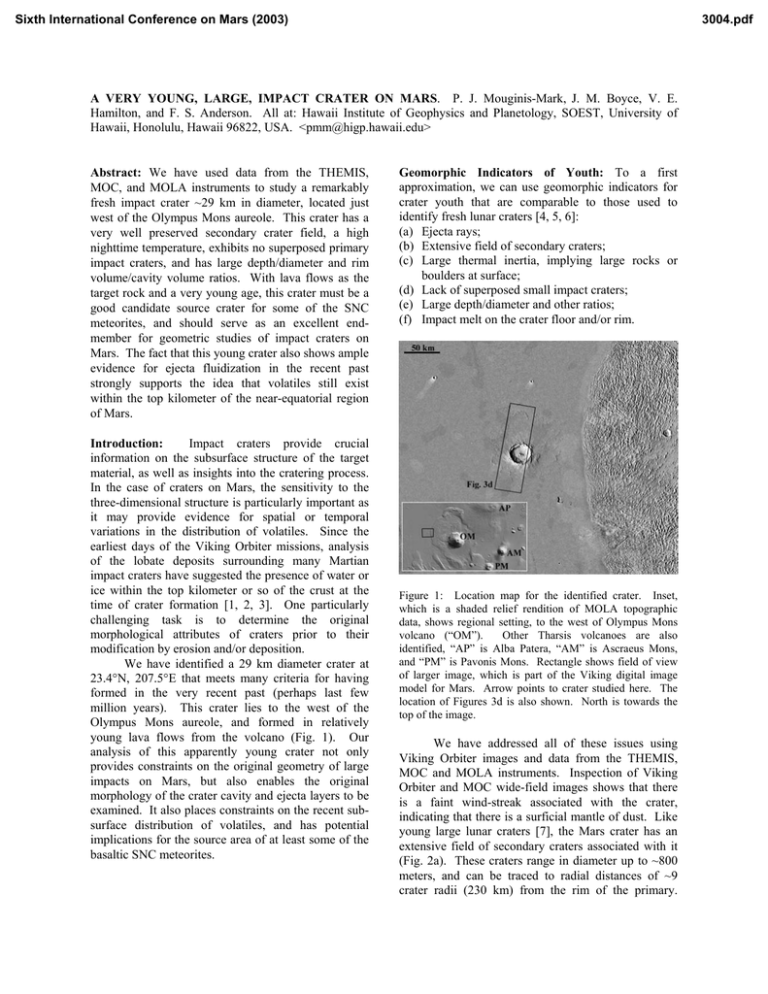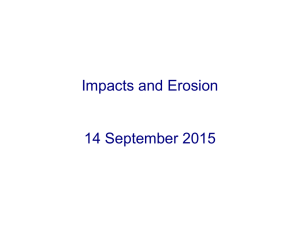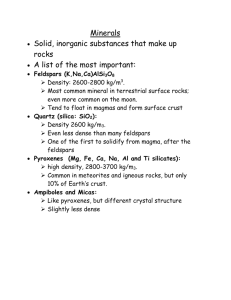A VERY YOUNG, LARGE, IMPACT CRATER ON MARS
advertisement

Sixth International Conference on Mars (2003) 3004.pdf A VERY YOUNG, LARGE, IMPACT CRATER ON MARS. P. J. Mouginis-Mark, J. M. Boyce, V. E. Hamilton, and F. S. Anderson. All at: Hawaii Institute of Geophysics and Planetology, SOEST, University of Hawaii, Honolulu, Hawaii 96822, USA. <pmm@higp.hawaii.edu> Abstract: We have used data from the THEMIS, MOC, and MOLA instruments to study a remarkably fresh impact crater ~29 km in diameter, located just west of the Olympus Mons aureole. This crater has a very well preserved secondary crater field, a high nighttime temperature, exhibits no superposed primary impact craters, and has large depth/diameter and rim volume/cavity volume ratios. With lava flows as the target rock and a very young age, this crater must be a good candidate source crater for some of the SNC meteorites, and should serve as an excellent endmember for geometric studies of impact craters on Mars. The fact that this young crater also shows ample evidence for ejecta fluidization in the recent past strongly supports the idea that volatiles still exist within the top kilometer of the near-equatorial region of Mars. Introduction: Impact craters provide crucial information on the subsurface structure of the target material, as well as insights into the cratering process. In the case of craters on Mars, the sensitivity to the three-dimensional structure is particularly important as it may provide evidence for spatial or temporal variations in the distribution of volatiles. Since the earliest days of the Viking Orbiter missions, analysis of the lobate deposits surrounding many Martian impact craters have suggested the presence of water or ice within the top kilometer or so of the crust at the time of crater formation [1, 2, 3]. One particularly challenging task is to determine the original morphological attributes of craters prior to their modification by erosion and/or deposition. We have identified a 29 km diameter crater at 23.4°N, 207.5°E that meets many criteria for having formed in the very recent past (perhaps last few million years). This crater lies to the west of the Olympus Mons aureole, and formed in relatively young lava flows from the volcano (Fig. 1). Our analysis of this apparently young crater not only provides constraints on the original geometry of large impacts on Mars, but also enables the original morphology of the crater cavity and ejecta layers to be examined. It also places constraints on the recent subsurface distribution of volatiles, and has potential implications for the source area of at least some of the basaltic SNC meteorites. Geomorphic Indicators of Youth: To a first approximation, we can use geomorphic indicators for crater youth that are comparable to those used to identify fresh lunar craters [4, 5, 6]: (a) Ejecta rays; (b) Extensive field of secondary craters; (c) Large thermal inertia, implying large rocks or boulders at surface; (d) Lack of superposed small impact craters; (e) Large depth/diameter and other ratios; (f) Impact melt on the crater floor and/or rim. Figure 1: Location map for the identified crater. Inset, which is a shaded relief rendition of MOLA topographic data, shows regional setting, to the west of Olympus Mons volcano (“OM”). Other Tharsis volcanoes are also identified, “AP” is Alba Patera, “AM” is Ascraeus Mons, and “PM” is Pavonis Mons. Rectangle shows field of view of larger image, which is part of the Viking digital image model for Mars. Arrow points to crater studied here. The location of Figures 3d is also shown. North is towards the top of the image. We have addressed all of these issues using Viking Orbiter images and data from the THEMIS, MOC and MOLA instruments. Inspection of Viking Orbiter and MOC wide-field images shows that there is a faint wind-streak associated with the crater, indicating that there is a surficial mantle of dust. Like young large lunar craters [7], the Mars crater has an extensive field of secondary craters associated with it (Fig. 2a). These craters range in diameter up to ~800 meters, and can be traced to radial distances of ~9 crater radii (230 km) from the rim of the primary. Sixth International Conference on Mars (2003) Inspection of MOC images at 6 m/pixel (Fig. 2b) shows that there are small dunes on the floors of some of these secondary craters, indicating that their infilling has already commenced. 3004.pdf of these sizes would be easily identified in MOC images if they existed. Thus it is not possible to place this unit into the context of young volcanic surfaces studied by Hartmann [8] because the surface is essentially pristine. No production curve has been proposed for surfaces younger than 10 myr, but we infer that the crater studied here is significantly younger than 10 myr. Figure 2: (a - left) Extensive secondary crater field to the south of the primary shows chains of craters radial to the primary. THEMIS image V01990003, at 18 m/pixel. (b right) Subscene of MOC image M1301995 (6.0 m/pixel) showing rectangular secondary crater just beyond the northern ejecta lobe. Dunes can be identified on the floor of the crater, which is ~800 m in diameter. See Figure 3d for locations. Remnants of the crater floor between the central peak and the inner wall (Fig. 3a) are also rarely seen in craters on Mars, due most likely to subsequent eolian or fluvial in-filling. On the crater floor, there are materials that are very different from those typically seen on the interior of Martian craters, and we interpret these materials to be ponded melt sheets (Fig. 3b) comparable to those seen on the floor of Copernicus crater on the Moon [4]. The classic interior features of young lunar craters such as King, Copernicus and Necho [4, 5] can also be seen on the Mars crater. MOC images also reveal flow material that appears to be impact melt on both the inner upper walls and the exterior rim of the crater (Fig. 3c). The ejecta lobes bear further evidence of the very young age of the crater. MOC images (Fig. 4) reveal a very wide range of morphologies on the ejecta lobes to the north of the crater. A diversity of radial flow patterns can be seen on the lobes, and details in the shear-lines associated with the radial motion of the ejecta during emplacement can be seen. Also of importance is the total lack of smaller impact craters on many of the ejecta lobes. Remarkably, MOC images of the northern ejecta lobe, obtained at a spatial resolution of 6.0 m/pixel show that no impact craters down to the resolution limit exist over an area of 72 km2 of the deposit. Hartmann [8] proposed that a Mars crater production surface with an age of 10 myr. would have ~10 craters/km2 with a diameter of ~30 m, or 1 crater per ten km2 with a diameter of ~100 m. Craters Figure 3: (a – top left) Well preserved massive rock unit on the inner terrace; (b – center left) Polygonal ground on floor of crater to south of central peak; (c – bottom left) Flow-like features that may be impact melt on the southern outer wall. All images are sub-scenes of MOC image E0500856 (4.53 m/pixel). See Figure 3d for locations. (d - right) THEMIS daytime IR image I01990002 (100 m/pixel) showing the locations of higher resolution images presented here. See Figure 1 for location. The THEMIS thermal data provide evidence for a regional dust mantle, although nighttime IR data Sixth International Conference on Mars (2003) (THEMIS frame number I02009003) reveal a strong (~30 K) thermal contrast between the crater walls, exterior rim, and floor compared to the adjacent terrain. A maximum thermal inertia of ~375 J m-2 S-1/2 K-1 was calculated for the southeastern inner rim, based on a thermal model for the appropriate latitude, time of day, elevation and season. This thermal inertia is neither consistent with a thick dust mantle nor bedrock, and likely represents a rocky surface with a thin mantle of dust (relative to the surroundings). This interpretation is supported by the thermal IR data. We produced decorrelation streched images of this crater, but could find no spatial variation in mineralogy, consistent with an optically thick (at thermal wavelengths) dust coating. Interestingly, this crater is the only one so far observed that has a small nighttime thermal high associated with the distal ejecta ramparts. The availability of high resolution gridded topography (1/128th degree, or ~450 m/pixel) from the MOLA instrument allows us to assess the crater’s morphology. Using Viking data [6, 9] and individual MOLA profiles through the center of impact craters [10], several investigators argued that Mars impact craters with high depth/diameter and rim height/diameter ratios are less modified (i.e., younger) than other craters of comparable size. We have utilized a new software package [11] that enables many different geometric attributes for impact craters to be measured using the MOLA gridded topography. We have measured the study crater and compared its geometry to 149 other craters on Mars (focusing on craters in Hesperia, Lunae, and Sinai Plana). We have measured crater diameter, rim height, depth of crater below the surrounding terrain, and rim and cavity volumes. Plots of crater diameter against total crater depth (i.e., maximum rim height to lowest point on crater floor), cavity volume, and rim volume all reveal that, for its size, the crater under study has dimensions consistent with a very young age. All three attributes (depth, cavity volume and rim volume) are high for the diameter of the crater, and could be interpreted in terms of the lack of erosion and/or in-filling that has modified the original crater shape. Implications: Analysis of the Olympus Mons aureole crater has implications for several diverse aspects of the geologic evolution of Mars. Most interesting, perhaps, is that it shows that even during the very recent past of Mars, the medium that produces fluidized ejecta was still present. Whether this fluidization is caused by volatiles in the target rock, or the atmosphere, there appears to be nothing to distinguish the level of fluidity (i.e., travel distance) of the ejecta, or the general morphologic characteristics of this crater from craters formed in much earlier 3004.pdf geologic times on Mars. If volatiles in the target rock produce the fluid behavior, the amount of volatiles in the top few hundred meters most likely has not changed in the last ~10 million years even at relatively near-equatorial locations, so that a similar concentration of volatiles may still be present at this latitude. Alternatively, if the atmosphere was the fluidization medium, then the process can operate in a thin (<10 mbar) atmosphere, and older fluidized ejecta deposits cannot be used as indicators of a thicker earlier atmosphere. We also note that this crater is located at a site where the Mars Odyssey GRS experiment indicates that there is a moderate epithermal neutron flux (~6.5 counts/sec) which would be indicative of a low hydrogen concentration [12]. Thus our observations support the idea of a layered target with more volatiles at a depth of a few hundred meters than at the surface. Figure 4: (a - left) Proximal surface of ejecta lobe ~12 km north of crater rim. Direction of flow is toward top of image. (b - right) Flow pattern on middle portion of the ejecta lobe ~23 km north of crater rim. Note the total absence of superposed craters on both parts of the ejecta lobe. The direction of flow is towards the top of the image. Parts of MOC image M1301995 (6.0 m/pixel). See Figure 3d for locations. The crater geomorphology also provides information about ejecta flow processes. Specific observations of the amount of topography preserved in the distal ramparts, and the shear structure of the lobes, implies that the ejecta “froze” while it was still moving. We have co-registered the VIS THEMIS data Sixth International Conference on Mars (2003) with the MOLA 128th degree DEM, and measured the heights of the distal ramparts to be as great as 117 m. There appears to have been insufficient time for the ejecta lobe to relax after it came to rest for the decameter-scale topography to have been removed. Our observations suggest that current models of rampart flow rheology [2, 13] are incomplete and require revision to adequately explain the topographic characteristics observed at this young crater. The apparent youth of this crater and its presence on relatively young lava flows suggest that it may be a candidate source crater for some of the youngest Martian meteorites. Many basaltic shergottites have crystallization ages of ~175 m.yr., leading to the prediction that they may have come from somewhere in Tharsis [14]. Basaltic shergottite spectra do not match thermal infrared spectra of Martian dark regions [15], also leading to the suggestion that one or more of their source regions may be located in Tharsis. Ejection ages for most of the shergottites are <~3 million years [14], which could be consistent with the youthful morphology for the aureole crater. Further analyses of the Olympus Mons aureole crater are ongoing. Mapping the size, number and radial distribution of the secondary craters will help establish the importance of secondary cratering on Mars, which has implications for the establishment of flux curves and relative age dating for the planet. More detailed studies of the distribution of material within the ejecta lobes will benefit from the fact that the impact event took place on a nearly flat-lying lava flow field that has no other craters in the vicinity. This characteristic will facilitate highly accurate height and volume measurements for individual ejecta lobes, which in turn will be valuable for the construction of rheologic models for the surface emplacement of ejecta on Mars [13, 16]. Finally, we note that although the crater studied here may not be the absolute youngest large (>20 km diameter) crater on Mars, it nevertheless provides a standard to which other fresh craters on different terrains can be compared. As more THEMIS data are collected, the comparison of very young craters on different target rocks may yield important information about the surface layers of the crust. Acknowledgments: We thank Jim Garvin and Phil Christensen for discussions on the uses of the MOLA and THEMIS data sets for making measurements of Martian impact craters. Harold Garbeil wrote the software used here to measure the geometry of impact craters from the MOLA DEM. 3004.pdf References: [1] Carr, MH, L Crumpler, J Cutts, R Greeley, J Guest and H Masursky (1977). Martian impact craters and emplacement of ejecta by surface flow. J. Geophys. Res. 82, 4055 - 4065. [2] Gault, DE, and R Greeley (1978). Exploratory experiments of impact craters formed in viscous targets: Analogs for Martian rampart craters. Icarus 34, 486 – 495. [3] Mouginis-Mark, PJ (1979). Martian fluidized crater morphology: Variations with crater size, latitude, altitude and target material. J. Geophys. Res. 84, 8011 – 8022. [4] Howard, KA and HG Wilshire (1975). Flows of impact melt at lunar craters, J. Res. U.S. Geol. Survey 3, 237 – 251. [5] Hawke, BR and JW Head (1977). Impact melt on lunar crater rims. In Impact & Explosion Cratering (DJ Roddy, RO Pepin and RB Merrill, editors), pp. 815 – 841, Pergamon Press, N.Y. [6] Pike RJ (1980). Control of crater morphology by gravity and target type: Mars, Earth, Moon. Proc. Lunar Planet. Sci. Conf. 11th, 2159 – 2189. [7] Oberbeck, VR and RH Morrison (1973) On the formation of the lunar herringbone pattern, Proc. Fourth Lunar Sci. Conf., 107 – 123. [8] Hartmann, WK (1999). Martian cratering VI: Crater count isochrons and evidence for recent volcanism from Mars Global Surveyor. Meteoritics & Planetary Science 34, 167 – 177. [9] Cintala, MJ and PJ Mouginis-Mark (1980). Martian fresh crater depth: More evidence for subsurface volatiles. Geophys. Res. Lttrs 7, 329 – 332. [10] Garvin, JB, SHE Sakimoto, JJ Frawley and C Schnetzler (2000). North polar region craterforms on Mars: Geometric characteristics from the Mars Orbiter Laser Altimeter. Icarus 144, 329 – 352. [11] Mouginis-Mark, PJ, H Garbeil, JM Boyce, SM Baloga and C Ui (2003). Measurement of Martian impact crater geometry via a new interactive computer program. Lunar & Planetary Science XXXIV, #1472. [12] Boynton WV and 24 other (2002). Distribution of hudrogen in the near surface of Mars: Evidence for subsurface ice deposits. Science 297, 81 – 85. [13] Baratoux, D, C Delacourt, and P Allemand (2002). An instability mechanism in the formation of the Martian lobate craters and the implications for the rheology of ejecta. Geophys. Res. Lttrs. 29, 10.1029/2001GL013779. [14] Nyquist, LE, DD Bogard, C-Y Shih, A Greshake, D Stoffler, and O Eugster (2001). Ages and geologic histories of Martian meteorites. Chron. Evol. Mars 96, 105 – 164. [15] Hamilton, VE, PR Christensen, HY McSween, and JL Banfield. Searching for the source regions of Martian meteorites using MGS TES: Integrating Martian meteorites into the global distribution of igneous materials on Mars, submitted to Meteor. Planet. Sci. [16] Stewart, ST, JD O’Keefe, and TJ Ahrens, Impact processing and redistribution of nearsurface water on Mars, submitted to Nature, 2003.





